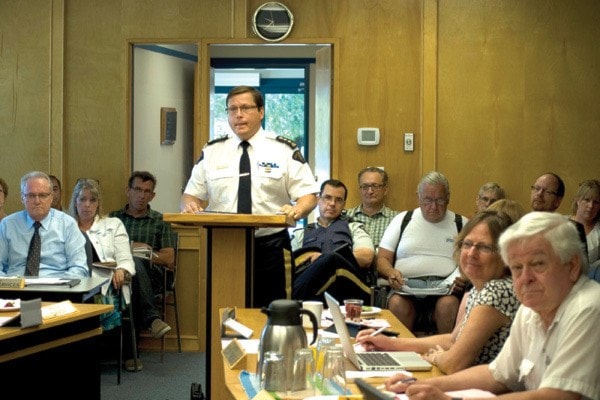By Barn Brouwer - Salmon Arm Observer
Columbia Shuswap Regional District directors got a chance to air their beefs about rural policing at last Thursday’s board meeting.
Mike Sekela, chief superintendent of the RCMP’s Southeast District, attended the meeting to listen to gripes and answer questions.
In charge of communications and policing in rural areas, Sekela oversees 45 detachments.
First up was Area D director René Talbot, who represents constituents in Falkland, Silver Creek, Deep Creek and Ranchero.
“You might as well close the office down,” he said of Falkland, noting there are supposed to be three officers assigned to the detachment. “Nobody is ever there.”
Long frustrated by a change in police coverage to the area, Talbot complained that it took police 45 minutes to respond to a recent fatal motorcycle accident.
Talbot also expressed concerns about the effect of the Stomp in Silver Creek and Sturgis North on Falkland.
“Last year, we had Sturgis North, with events in Kelowna, Vernon and Salmon Arm, but they used Falkland as a meeting place,” he said. “There were hundreds of motorcycles and no police in sight.”
While Salmon Arm Mayor Nancy Cooper applauded police presence at local events, Area E Rural Sicamous director Rhona Martin said she would like to a bigger presence in rural areas.
“For many years we’ve been asking for an increased number of cops,” she said, pointing out she would like RCMP officers to socialize and mingle, and get to know residents – particularly children.
Talbot, a Falkland resident, agreed, pointing out that RCMP members used to go into schools and take their coffee breaks in town, where they interacted with residents.
“Now they come in, they do what they need to do and they’re gone again,” he said. “When people don’t know cops, information does not flow. People miss not seeing and not knowing the cops in our area.”
In responses, Sekela said numbers are based on geography of an area, size, on-call hours and calls for service.
He promised to share the results of a rural policing study currently underway.
“There are ways to increase resources and I am looking at that in terms of regional districts,” he said. “Some are looking at a bylaw to “buy” policemen… I will get details, and can explore those options.”
Martin told him she is familiar with the Christina Lake program, which involves using grant-in-aid funds.
“We have high assessments and they’re paying considerably more for policing in (electoral areas) F and E, but the detachment has not grown since when?” she asked, taking issue with using the number of call-outs to an area as a basis for providing police service.
“Calls is a flawed way to do it,” she said. “I recall (Area C) Ted Bacigalupo saying years ago that nobody calls the police anymore because they don’t come, so what’s the use?’”
On a more congratulatory note, Sicamous Mayor Darrel Trouton, expressed his appreciation for members of his detachment for going “above and beyond,” in their response to recent flooding.
Also expressing thanks was Area F North Shuswap director Larry Morgan.
“I think policing presence in our area is much improved,” he said. “We have a good relationship with the detachment and we are pleased with (Chase Sgt.) Gary Heebner’s aggressive attitude in dealing with issues.”
Wrapping up, Sekela told directors he noted directors’ concerns, which are common to other areas as well.
But he advised the RCMP has to make the best uses of available resources.
“Some things do suffer, but others are enhanced and maybe that’s response time,” he said. “It’s economically not feasible to have cops in every community, but I will make sure it will be the best service with the resources we have.”
